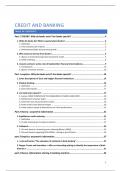Summary
Summary Credit and banking KUL '23-'24 (16/20)
- Course
- Institution
This is my (extensive) summary of the course Credit and Banking. Everything that was covered in class is in here with all my notes and drawings from the lecture itself.
[Show more]



